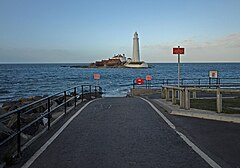Whitley Bay
| Whitley Bay | |
|---|---|
 St. Mary's Island Road leading to the tidal causeway |
|
| Whitley Bay shown within Tyne and Wear | |
| Population | 36,623 (2013. North Tyneside Population Statistics - Whitley Bay comprises four wards: Monkseaton North 9,121; Monkseaton South 9.881; St. Mary's 8,275 and Whitley Bay Central 9,346) |
| OS grid reference | NZ3572 |
| Metropolitan borough | |
| Metropolitan county | |
| Region | |
| Country | England |
| Sovereign state | United Kingdom |
| Post town | WHITLEY BAY |
| Postcode district | NE25, NE26 |
| Dialling code | 0191 |
| Police | Northumbria |
| Fire | Tyne and Wear |
| Ambulance | North East |
| EU Parliament | North East England |
| UK Parliament | |
Whitley Bay is a seaside town on the north east coast of England. Historically in Northumberland, it is now part of Tyne and Wear. It has absorbed the village of Monkseaton.
Whitley was first mentioned around 1100 when King Henry I conferred it with other possessions on the Priory of Tynemouth being referred to in ancient documents and maps before that date as Witelei, Wyteley, Hwyteleg, Witelithe, Wheteley, Wytheleye, Whitlaw, Whitlathe and Whitlag. Whitley is also referred to in the charters of King Henry II, King Richard I and King John, confirming to the priors their possessions and liberties.
Whitley was connected with the Crusades when Pope Nicholas IV granted to Edward I the first-fruits and tenths of all ecclesiastical possessions for six years to defray the expenses of an expedition to the Holy Land. A valuation was made of the spiritual and temporal goods of the Priory on 26 March 1292, when the yearly rents from Whitley were returned as 20 shillings, and the tithes as 9 marks.
About the beginning of the 14th century, the manor of Whitley was held from the Prior of Tynemouth by a singular feudal service called the Conveyes which seems to have originated from John de Whitley. Richard de Emeldon, eighteen times Mayor of Newcastle and seven times its representative in Parliament, was the Lord of the Manor of Whitley in 1333.
On 9 April 1345, Edward III granted Gilbert de Whitley a licence to crenellate his manor house at Whitley. To crenellate a house was to place battlements on it. Before this could be done, the sanction of the Crown was often sought. Although battlements were often largely symbolic, in this instance it is probably an indication of the degree of insecurity felt even this far south during the Edwardian wars with Scotland. The licence and crenellations were an indication of status. Only 2% of the small tower houses of the sort Gilbert built had licences. The 'sanction' of the crown was a sought-after bonus, but not a requirement.
...
Wikipedia

